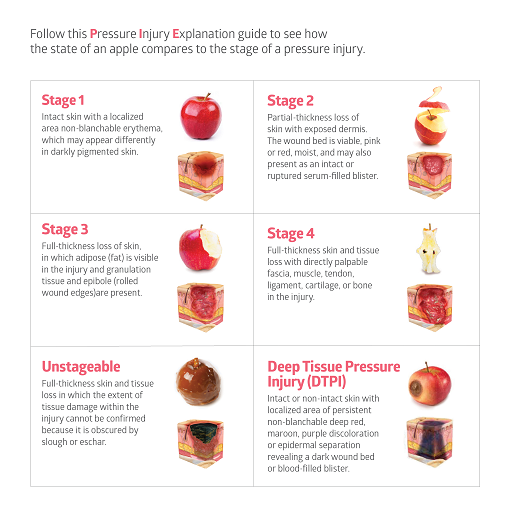We use cookies to make your experience better. To comply with the new e-Privacy directive, we need to ask for your consent to set the cookies.
Much has been written over the years about wound care in long-term care settings; the challenges, the protocols and the evolving efforts. As a person ages, skin becomes more susceptible to injuries and damage. Skin doesn’t heal as quickly as it once did due to fragility, dryness, loss of elasticity and other factors.
Pressure injuries or bedsores happen when a person sits or lies in a position for long periods, and the pressure of the surface on the skin results in injury. These injuries may be more common over bony parts of the body such as the hips, heels, tailbone, elbows and ankles. If they become severe, these injuries can be challenging to treat and take longer to heal. The results can even mean life-threatening skin, blood and bone infections.
Accurate staging is an important aspect of pressure injury assessment as different wound conditions require different treatments and interventions. When wounds are accurately identified in the correct stage it can lead to more precise treatment plans and better patient and clinical outcomes. Staging can also help in preventing further pressure injuries, and healthcare provider education is key to identifying and reducing risk.
Pressure Injury Staging is as easy as Apple P.I.E.
Patty Turner, BSN, RN, CWOCN, CWS, Director of Clinical Services at Medline, has developed a patented Apple P.I.E. (Pressure Injury Explanation) concept to help educate healthcare providers. The Apple P.I.E. system shows each stage of pressure injury and is compared with the states of an apple’s deterioration, from unblemished to completely eaten. For example, Stage 1 corresponds with an apple's familiar, bright red color, Stage 4 with one eaten down to the core, and Unstageable is likened to a caramel apple – meaning it’s not possible to see what lies beneath it.
“These comparisons offer an easy and memorable way to clarify confusion around pressure injury stages,” says Turner. “In a fast-paced care environment, clinicians may not have the time to retrain staff to identify injury stages repeatedly, but pressure injury staging doesn't need to be difficult."
Using an example like the Apple P.I.E. helps to reduce confusion around pressure injuries and can be used to confidently identify and understand the visible differences between each stage of such injuries.
Reducing the prevalence of avoidable pressure injuries begins with careful observation of the skin and frequent repositioning. This may be challenging in long-term care, where staffing levels continue to be a system-wide struggle. The ease of a system like Apple P.I.E. helps efficiently support care provision.
Just like the people affected by them, wounds should get treated individually. The Medline DIMES system of wound bed preparation and treatment provides a simple method to help clinicians select the best product based on wound condition:
- Debridement (Autolytic): The removal of nonviable tissue by creating an optimal moist wound environment.
- Infection/Inflammation: Addressing bioburden and inflammation in the wound.
- Moisture Balance: Achieving and maintaining moisture balance in and around the wound.
- Edge/Environment: Treating stalled wounds where epithelium fails to migrate.
- Support products, services and education: Products to enhance outcomes and round out your wound healing toolkit.
In addition to recognizing the stages of skin injury, some products help prevent skin injuries.
Some examples include:
- Advanced heel protectors to help reduce friction, create cushioning and still allow for airflow and easy monitoring.
- Foam wedges provide patients with firm support and can help caregivers with repositioning.
- Scientifically formulated, purpose-made products such as Medline’s Remedy® solutions, for topical cleansing, moisturizing, barrier creation and irritation prevention for at-risk skin, with active ingredients that speed healing.
- Special moisture-wicking pads to help promote dryness and comfort.
- New transparent bandage technology to help cushion and protect while providing a clear view of skin and decreasing the need for dressing changes.
A good skincare and wound prevention strategy can provide long-term care settings with a proactive approach to lowering costs and critical resource usage associated with patient pressure injuries and ultimately reduce the risk of long-term care patients requiring acute treatment for complex wound and skin issues.

